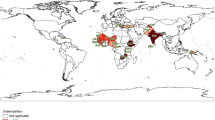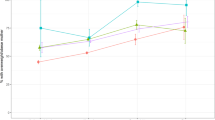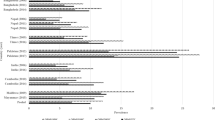Abstract
Background/Objectives
This study determined time trends in the prevalence of malnutrition and its socioeconomic inequality among children under five at a national level and by urbanity in Thailand.
Subjects/Methods
This study compared malnutrition prevalence and inequality among children under five by wealth index score and urbanity using three Multiple Indicator Cluster Surveys for 2005–06, 2012, and 2015–16. The magnitude of inequality was measured on absolute (slope index of inequality) and relative scales (relative index of inequality).
Results
National prevalence of stunting decreased substantially (16% in 2005–06 and 2012 and 10% in 2015–16), whereas overweight prevalence did not meaningfully change. Inequalities in stunting and overweight by wealth decreased over time nationally on both absolute and relative scales (p-trend < 0.001). Similar decreasing patterns in inequalities were seen in both rural and urban areas, though substantial inequalities persisted. Poor children remained stunted (11.6% in the rural poor and 14.8% in the urban poor), wasted (6.6% in the rural poor), and, strikingly, also overweight (from 5.5% in 2005–06 to 9% in 2015–16 for the rural poor and 8% over time for the urban poor).
Conclusion
Despite favorable time trends in socioeconomic inequality, this study showed the existence of a double burden of malnutrition (under-nutrition and overweight) in young Thai children with persistent inequalities at the national level. Different patterns of this double burden were seen between urban and rural areas. Public health policies should target both under-nutrition and overweight and consider urbanity in this rapidly developing society.
This is a preview of subscription content, access via your institution
Access options
Subscribe to this journal
Receive 12 print issues and online access
$259.00 per year
only $21.58 per issue
Buy this article
- Purchase on Springer Link
- Instant access to full article PDF
Prices may be subject to local taxes which are calculated during checkout
Similar content being viewed by others
References
United Nations Children’s Fund (UNICEF), World Health Organization, International Bank for Reconstruction and Development/The World Bank. Levels and trends in child malnutrition: key findings of the 2019 Edition of the Joint Child Malnutrition Estimates. Geneva: World Health Organization; 2019 Licence: CC BY-NC-SA 3.0 IGO.
Paciorek CJ, Stevens GA, Finucane MM, Ezzati M, Nutrition Impact Model Study Group. Children’s height and weight in rural and urban populations in low-income and middle-income countries: a systematic analysis of population-representative data. Lancet Glob Health. 2013;1:e300–9. https://doi.org/10.1016/S2214-109X(13)70109-8
Mberu BU, Haregu TN, Kyobutungi C, Ezeh AC. Health and health-related indicators in slum, rural, and urban communities: a comparative analysis. Glob Health Action. 2016;9:33163. https://doi.org/10.3402/gha.v9.33163
WHO. World health statistics 2016: monitoring health for the SDGs. Geneva: WHO; 2016.
Gwatkin DR. Health inequalities and the health of the poor: what do we know? What can we do? Bull World Health Organ. 2000;78:3–18.
da Silva ICM, França GV, Barros AJD, Amouzou A, Krasevec J, Victora CG. Socioeconomic inequalities persist despite declining stunting prevalence in low- and middle-income countries. J Nutr. 2018;148:254–8. https://doi.org/10.1093/jn/nxx050
Bredenkamp C, Buisman LR, Van de Poel E. Persistent inequalities in child undernutrition: evidence from 80 countries, from 1990 to today. Int J Epidemiol. 2014;43:1328–35. https://doi.org/10.1093/ije/dyu075
Van de Poel E, Hosseinpoor AR, Speybroeck N, Van Ourti T, Vega J. Socioeconomic inequality in malnutrition in developing countries. Bull World Health Organ. 2008;86:282–91.
Black RE, Victora CG, Walker SP, Bhutta ZA, Christian P, de Onis M, et al. Maternal and child undernutrition and overweight in low-income and middle-income countries. Lancet. 2013;382:427–51. https://doi.org/10.1016/S0140-6736(13)60937-X
Garcia V. Children malnutrition and horizontal inequalities in sub-saharan Africa: a focus on contrasting domestic trajectories. United Nations Development Programme; 2012.
Neuman M, Kawachi I, Gortmaker S, Subramanian SV. Urban-rural differences in BMI in low- and middle-income countries: the role of socioeconomic status. Am J Clin Nutr. 2013;97:428–36. https://doi.org/10.3945/ajcn.112.045997
Smith LC, Ruel MT, Ndiaye A. Why is child malnutrition lower in urban than in rural areas? Evidence from 36 developing countries. World Dev. 2005;33:1285–305.
Fox K, Heaton TB. Child nutritional status by rural/urban residence: a cross-national analysis. J Rural Health. 2012;28:380–91.
Srinivasan CS, Zanello G, Shankar B. Rural-urban disparities in child nutrition in Bangladesh and Nepal. BMC Public Health. 2013;13:581. https://doi.org/10.1186/1471-2458-13-581
UN. World urbanization prospects: the 2014 revision, highlights (ST/ESA/SER.A/352). New York: Population Division of the Department of Economic and Social Affairs of the United Nations Secretariat; 2014.
Winichagoon P. Thailand nutrition in transition: situation and challenges of maternal and child nutrition. Asia Pac J Clin Nutr. 2013;22:6–15.
Food and Agriculture Organization of the United Nations. Thailand—food and nutrition security profiles. Food and Agriculture Organization of the United Nations; 2014.
Aekplakorn W, Mo-Suwan L. Prevalence of obesity in Thailand. Obes Rev. 2009;10:589–92. https://doi.org/10.1111/j.1467-789X.2009.00626.x
Yamborisut U, Mo-Suwan L. Prevalence of childhood and adolescent obesity in Thailand: a review. J Med Assoc Thai. 2014;97:44–51.
International Food Policy Research Institute. Global nutrition report: governance International Food Policy Research Institute; 2014.
International Food Policy Research Institute. 2017 global food policy report. Washington, DC: International Food Policy Research Institute; 2017.
Thailand National Statistical Office and UNICEF. Thailand Multiple Indicator Cluster Survey (MICS) 2012, final report. Bangkok, Thailand: Thailand National Statistical Office and United Nations Children’s Fund; 2012.
Thailand National Statistical Office. Thailand Multiple Indicator Cluster Survey (MICS) 2016, final report. Bangkok, Thailand: Thailand National Statistical Office; 2016.
Thailand National Statistical Office. Thailand Multiple Indicator Cluster Survey (MICS) December 2005–February 2006, final report. Bangkok, Thailand: Thailand National Statistical Office; 2006.
WHO. WHO child growth standards: length/height-for-age, weight-for-age, weight-for-length, weight-for-height and body mass index-for-age: methods and development. Geneva, Switzerland: WHO; 2006.
Houweling TA, Kunst AE, Mackenbach JP. Measuring health inequality among children in developing countries: does the choice of the indicator of economic status matter? Int J Equity Health. 2003;2:8. https://doi.org/10.1186/1475-9276-2-8
Gwatkin DR, Rutstein S, Johnson K, Pande R, Wagstaff. A. Socio-economic differences in health, nutrition, and population. Washington, DC: World Bank, HNP/Poverty Thematic Group; 2001.
Mackenbach JP, Kunst AE. Measuring the magnitude of socio-economic inequalities in health: an overview of available measures illustrated with two examples from Europe. Soc Sci Med. 1997;44:757–71. https://doi.org/10.1016/S0277-9536(96)00073-1
Moreno-Betancur M, Latouche A, Menvielle G, Kunst AE, Rey G. Relative index of inequality and slope index of inequality: a structured regression framework for estimation. Epidemiology. 2015;26:518–27. https://doi.org/10.1097/EDE.0000000000000311
Regidor E. Measures of health inequalities: part 2. J Epidemiol Community Health. 2004;58:900. https://doi.org/10.1136/jech.2004.023036
Mackenbach JP, Stirbu I, Roskam AJ, Schaap MM, Menvielle G, Leinsalu M, et al. Socioeconomic inequalities in health in 22 European countries. N Engl J Med. 2008;358:2468–81. https://doi.org/10.1056/NEJMsa0707519
Khang YH, Lynch JW, Yun S, Lee SI. Trends in socioeconomic health inequalities in Korea: use of mortality and morbidity measures. J Epidemiol Community Health. 2004;58:308–14. https://doi.org/10.1136/jech.2003.012989
Espelt A, Kunst AE, Palència L, Gnavi R, Borrell C. Twenty years of socio-economic inequalities in type 2 diabetes mellitus prevalence in Spain, 1987–2006. Eur J Public Health. 2012;22:765–71. https://doi.org/10.1093/eurpub/ckr158
Spiegelman D, Hertzmark E, Easy SAS. calculations for risk or prevalence ratios and differences. Am J Epidemiol. 2005;162:199–200. https://doi.org/10.1093/aje/kwi188
Monteiro CA, Benicio MH, Conde WL, Konno S, Lovadino AL, Barros AJ, et al. Narrowing socioeconomic inequality in child stunting: the Brazilian experience, 1974–2007. Bull World Health Organ. 2010;88:305–11. https://doi.org/10.2471/BLT.09.069195
Greffeuille V, Sophonneary P, Laillou A, Gauthier L, Hong R, Hong R, et al. Persistent inequalities in child undernutrition in Cambodia from 2000 until today. Nutrients. 2016;8:297. https://doi.org/10.3390/nu8050297
Kien VD, Lee HY, Nam YS, Oh J, Giang KB, Minh HV. Trends in socioeconomic inequalities in child malnutrition in Vietnam: findings from the Multiple Indicator Cluster Surveys, 2000–11. Glob Health Action. 2016;9:29263. https://doi.org/10.3402/gha.v9.29263
Prakongsai P, Limwattananon S, Tangcharoensathien V. The equity impact of the universal coverage policy: Lessons from Thailand. Adv Health Econ Health Serv Res. 2009;21:57–81.
Kongsri S, Limwattananon S, Sirilak S, Prakongsai P, Tangcharoensathien V. Equity of access to and utilization of reproductive health services in Thailand: national reproductive health survey data, 2006 and 2009. Reprod Health Matters. 2011;19:86–97. https://doi.org/10.1016/S0968-8080(11)37569-6
Kelly M, Seubsman S, Banwell C, Dixon J, Sleigh A. Thailand’s food retail transition: supermarket and fresh market effects on diet quality and health. Br Food J. 2014;116:1180–93. https://doi.org/10.1108/BFJ-08-2013-0210
Hong SA, Sriburapapirom S, Thamma-aphiphol K, Jalayondeja C, Tiraphat S. Overweight and obesity among primary schoolchildren in Nakhon Pathom, Thailand: comparison of Thai, international obesity task force and WHO Growth references. Southeast Asian J Trop Med Public Health. 2017;48:902–11.
Jaacks LM, Vandevijvere S, Pan A, McGowan CJ, Wallace C, Imamura F, et al. The obesity transition: stages of the global epidemic. Lancet Diabetes Endocrinol. 2019;7:231–40. https://doi.org/10.1016/S2213-8587(19)30026-9
Gordon-Larsen P, Wang H, Popkin BM. Overweight dynamics in Chinese children and adults. Obes Rev. 2014;15(Suppl 1):37–48. https://doi.org/10.1111/obr.12121
Victora CG, Vaughan JP, Barros FC, Silva AC, Tomasi E. Explaining trends in inequities: evidence from Brazilian child health studies. Lancet. 2000;356:1093–8. https://doi.org/10.1016/S0140-6736(00)02741-0
Popkin BM. Urbanization, lifestyle changes and the nutrition transition. World Dev. 1999;27:1905–16.
Kim R, Kawachi I, Coull BA, Subramanian SV. Contribution of socioeconomic factors to the variation in body-mass index in 58 low-income and middle-income countries: an econometric analysis of multilevel data. Lancet Glob Health. 2018;6:e777–86. https://doi.org/10.1016/S2214-109X(18)30232-8
Gale EL, Saunders MA. The 2011 Thailand flood: climate causes and return periods. Weather. 2013;68. https://doi.org/10.1002/wea.2133
Soekirman. Food and nutrition security and the economic crisis in Indonesia. Asia Pac J Clin Nutr. 2001;10(Suppl):S57–61.
Shrimpton R, Rokx C. The double burden of malnutrition: a review of global evidence. The International Bank for reconstruction and development. Washington DC: The World Bank; 2012.
Background of Child Support Grant [Internet]. Bangkok, Thailand: Child Support Grant, Department of Children and Youth; 2018. [updated 2018; cited 2019 June 20] Available from: https://csg.dcy.go.th/en/about/background
Acknowledgements
The authors would like to thank the Thailand National Statistical Office (NSO) and the UNICEF Thailand country office for permission to use the publicly available data from the three MICS rounds for the present study.
Author information
Authors and Affiliations
Contributions
SAH designed the research, performed the analysis, interpreted the results, and drafted the manuscript. PW and Y-HK interpreted the results, and revised the manuscript. All authors read and approved the manuscript.
Corresponding author
Ethics declarations
Conflict of interest
The authors declare that they have no conflict of interest.
Additional information
Publisher’s note Springer Nature remains neutral with regard to jurisdictional claims in published maps and institutional affiliations.
Rights and permissions
About this article
Cite this article
Hong, S.A., Winichagoon, P. & Khang, YH. Rural–urban differences in socioeconomic inequality trends for double burden of malnutrition in Thailand 2005–2016. Eur J Clin Nutr 74, 500–508 (2020). https://doi.org/10.1038/s41430-019-0510-1
Received:
Revised:
Accepted:
Published:
Issue Date:
DOI: https://doi.org/10.1038/s41430-019-0510-1



